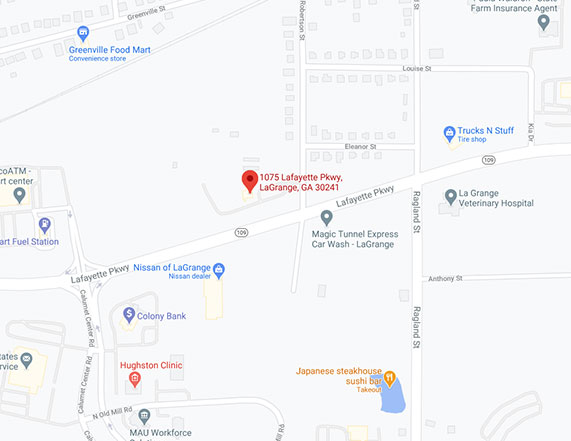Conveniently located to serve Newnan, Peachtree City and LaGrange
Click here to jump to:
Newnan Contact Dermatitis
WHAT IS CONTACT DERMATITIS?
Contact dermatitis is an eczematous skin disease that is caused by direct contact with another topical product. Most contact dermatitis reactions are dose related. The severity of the reaction depends on how long the exposure occurs, how much product contacts the skin and how irritating a particular substance is. Contact dermatitis can be categorized into two categories…irritant and allergic dermatitis.
Irritant contact dermatitis, is the more common subtype and occurs immediately after exposure to a specific compound (e.g. solvents or detergents).
Allergic contact dermatitis requires 24 to 48 hours before the skin rash develops. The most common contact allergen is nickel.
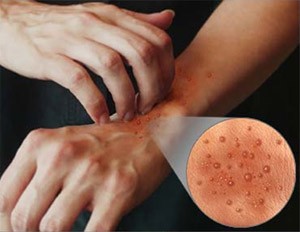
Contact Dermatitis – due to an allergen. In this area a watch could be the culprit.
HOW DO I RECOGNIZE A CONTACT DERMATITIS REACTION?
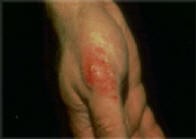
Contact Dermatitis – due to an allergy to Polysporin™ ointment.
Contact dermatitis usually presents as an eczematous rash and can be associated with blister formation. Skin can be easily rubbed off and oozes when the eruption is severe. In some instances, patients experience hives. Friction, low humidity and temperature of the skin can influence a contact dermatitis reaction.
WHAT ARE SOME OF THE AGENTS WHICH CAUSE CONTACT DERMATITIS?
Besides nickel, there are a variety of agents which can cause a contact dermatitis reaction. Soaps and detergents are sources for the irritant form of contact dermatitis while materials such as rubber, perfumes, neomycin, preservatives and formaldehyde tend to induce the allergic variety. It is important to note that a contact dermatitis rash can occur in an area different from where skin is exposed. For example, in some instances, it is possible to be allergic to the rubber compounds found in tennis shoe soles and manifest a hand dermatitis. Our providers can help you sort out the sometime confusing details of a contact dermatitis rash.
Related
Content
Patient
Review
“Great staff and nice atmosphere. Everyone is professional and very attentive. You will not be disappointed.”
by T
HOW IS THE DIAGNOSIS OF CONTACT DERMATITIS MADE?
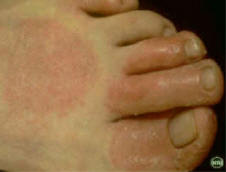
Contact Dermatitis due to shoe leather – note the distribution of this rash over the top of the foot.
Once the diagnosis of contact dermatitis is suspected, patch testing can be performed. Patch testing is performed in the office setting. Our providers will apply various strengths of topical compounds to the skin. They will then assess the tested areas in 48 hours to see if a localized skin rash develops. Once an allergen or irritant has been identified, the staff will review with you the sources of these agents. In this way you may practice avoidance techniques to avoid similar outbreaks in the future.
WHAT ARE SOME OF THE TREATMENTS FOR CONTACT DERMATITIS?
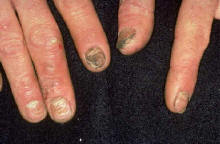
Contact Dermatitis on nails due to acrylates found in nail adhesives.
The main therapy for contact dermatitis reactions is avoidance of the irritating or allergic material. Our providers can also prescribe topical corticosteroid creams and oral antihistamines to help with any itching or discomfort. The use of protective clothing, e.g. cotton gloves or denim pants, may also be helpful. If you suspect that the work place is the cause of your skin rash, it is important to let us know of your concern. Your employer is responsible to compensate you for any lost wages due to work place related illnesses. A detailed dermatologic investigation can often sort out whether or not your work environment is the source of your skin rash.
For those with contact dermatitis, we may recommend:
- Patch testing
- Avoidance of those allergens identified.
- Avoidance of irritant sources such as caustic soaps, detergents or solvents.
- Follow our Sensitive Skin Care Tips
- That personal protective clothing be worn. These include items such as cotton gloves.
- Cerave Moisturizer twice daily after gently wetting the skin. . Lipikar™ is another emollient that is wonderful to use after wetting your skin twice a day during increased flares. Please remember to minimize hot water exposure as dry skin can often exacerbate your tendency to develop contact dermatitis
- Potent topical corticosteroids as directed.
- Avoid bleaching your underwear.
- Apply nail polish or felt to underside of your watch if you are nickel allergic.
- Preparation H™ or Crazy Glue can help heal fissures on fingers and hands to heal. Apply to fissures twice a day.
- Avoid candies that contain cinnamon if cinnamic aldehyde is the source of your allergy and you have a oral rash.
- Avoidance of the Sun or other light source (e.g. tanning parlors) until your skin rash improves. (If we suspect a photoallergic or phototoxic reaction this would necessitate that you avoid excessive sun exposure.)
- Burrow’s Solution (Aluminum Acetate soaks). Soak cotton gauze with Burrow’s solution and leave on the affected area for 5 to 10 minutes. Repeat this procedure 3 to 4 times a day.
- Contact your employer for any relevant Material and Safety Data Sheets (MSD sheets). We can assess and test the sources in your work environment to see if they are causing your skin reaction.
To summarize, contact dermatitis is manageable with early detection, avoidance, and topically prescribed creams. To set up an appointment with us, click here.











